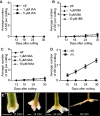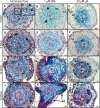Red Light Controls Adventitious Root Regeneration by Modulating Hormone Homeostasis in Picea abies Seedlings
- PMID: 33014006
- PMCID: PMC7509059
- DOI: 10.3389/fpls.2020.586140
Red Light Controls Adventitious Root Regeneration by Modulating Hormone Homeostasis in Picea abies Seedlings
Abstract
Vegetative propagation relies on the capacity of plants to regenerate de novo adventitious roots (ARs), a quantitative trait controlled by the interaction of endogenous factors, such as hormones and environmental cues among which light plays a central role. However, the physiological and molecular components mediating light cues during AR initiation (ARI) remain largely elusive. Here, we explored the role of red light (RL) on ARI in de-rooted Norway spruce seedlings. We combined investigation of hormone metabolism and gene expression analysis to identify potential signaling pathways. We also performed extensive anatomical characterization to investigate ARI at the cellular level. We showed that in contrast to white light, red light promoted ARI likely by reducing jasmonate (JA) and JA-isoleucine biosynthesis and repressing the accumulation of isopentyl-adenine-type cytokinins. We demonstrated that exogenously applied JA and/or CK inhibit ARI in a dose-dependent manner and found that they possibly act in the same pathway. The negative effect of JA on ARI was confirmed at the histological level. We showed that JA represses the early events of ARI. In conclusion, RL promotes ARI by repressing the accumulation of the wound-induced phytohormones JA and CK.
Keywords: Picea abies; adventitious roots; auxin; conifers; cytokinins; jasmonate; red light; root development.
Copyright © 2020 Alallaq, Ranjan, Brunoni, Novák, Lakehal and Bellini.
Figures






Similar articles
-
Jasmonate inhibits adventitious root initiation through repression of CKX1 and activation of RAP2.6L transcription factor in Arabidopsis.J Exp Bot. 2021 Oct 26;72(20):7107-7118. doi: 10.1093/jxb/erab358. J Exp Bot. 2021. PMID: 34329421 Free PMC article.
-
ETHYLENE RESPONSE FACTOR 115 integrates jasmonate and cytokinin signaling machineries to repress adventitious rooting in Arabidopsis.New Phytol. 2020 Dec;228(5):1611-1626. doi: 10.1111/nph.16794. Epub 2020 Aug 6. New Phytol. 2020. PMID: 32634250
-
Jasmonate promotes auxin-induced adventitious rooting in dark-grown Arabidopsis thaliana seedlings and stem thin cell layers by a cross-talk with ethylene signalling and a modulation of xylogenesis.BMC Plant Biol. 2018 Sep 6;18(1):182. doi: 10.1186/s12870-018-1392-4. BMC Plant Biol. 2018. PMID: 30189848 Free PMC article.
-
Hypocotyl adventitious root organogenesis differs from lateral root development.Front Plant Sci. 2014 Sep 29;5:495. doi: 10.3389/fpls.2014.00495. eCollection 2014. Front Plant Sci. 2014. PMID: 25324849 Free PMC article. Review.
-
Regulation of Phytohormones on the Growth and Development of Plant Root Hair.Front Plant Sci. 2022 Mar 24;13:865302. doi: 10.3389/fpls.2022.865302. eCollection 2022. Front Plant Sci. 2022. PMID: 35401627 Free PMC article. Review.
Cited by
-
Red and Blue Light Affect the Formation of Adventitious Roots of Tea Cuttings (Camellia sinensis) by Regulating Hormone Synthesis and Signal Transduction Pathways of Mature Leaves.Front Plant Sci. 2022 Jul 7;13:943662. doi: 10.3389/fpls.2022.943662. eCollection 2022. Front Plant Sci. 2022. PMID: 35873958 Free PMC article.
-
Influence of Additional White, Red and Far-Red Light on Growth, Secondary Metabolites and Expression of Hormone Signaling Genes in Scots Pine under Sunlight.Cells. 2024 Jan 19;13(2):194. doi: 10.3390/cells13020194. Cells. 2024. PMID: 38275819 Free PMC article.
-
How does light regulate plant regeneration?Front Plant Sci. 2025 Jan 29;15:1474431. doi: 10.3389/fpls.2024.1474431. eCollection 2024. Front Plant Sci. 2025. PMID: 39944943 Free PMC article. Review.
-
Adventitious Rooting in Populus Species: Update and Perspectives.Front Plant Sci. 2021 May 20;12:668837. doi: 10.3389/fpls.2021.668837. eCollection 2021. Front Plant Sci. 2021. PMID: 34093625 Free PMC article. Review.
-
Comparing adventitious root-formation and graft-unification abilities in clones of Argania spinosa.Front Plant Sci. 2022 Nov 14;13:1002703. doi: 10.3389/fpls.2022.1002703. eCollection 2022. Front Plant Sci. 2022. PMID: 36452103 Free PMC article.
References
-
- Abarca D., Díaz-Sala C. (2009). “Adventitious root formation in conifers,” in Adventitious Root Formation of Forest Trees and Horticultural Plants – from Genes to Applications. Eds. Niemi K., Scagel C. (Kerala, India: Research Signpost Publishers; ).
-
- Agulló-Antón M.Á., Sánchez-Bravo J., Acosta M., Druege U. (2011). Auxins or Sugars: What Makes the Difference in the Adventitious Rooting of Stored Carnation Cuttings? J. Plant Growth Regul. 30, 100–113. 10.1007/s00344-010-9174-8 - DOI
-
- Baque M. A., Hahn E.-J., Paek K.-Y. (2010). Induction mechanism of adventitious root from leaf explants of Morinda citrifolia as affected by auxin and light quality. Vitr. Cell. Dev. Biol. - Plant 46, 71–80. 10.1007/s11627-009-9261-3 - DOI
LinkOut - more resources
Full Text Sources
Research Materials

